VERY RARE Antique Pink & Green Opalescent Art Glass Miniature Oil Lamp, S1-538
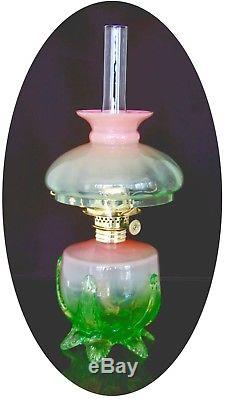
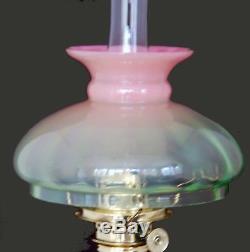
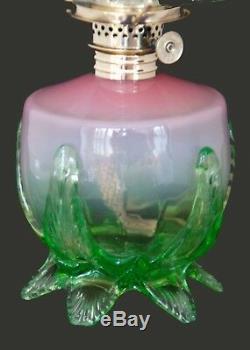
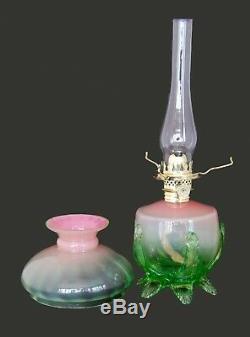
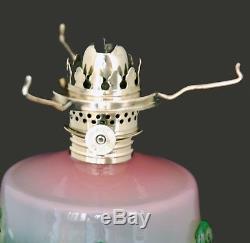
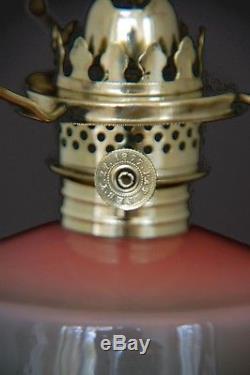
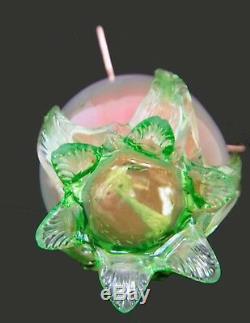
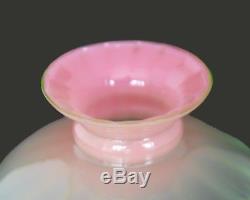
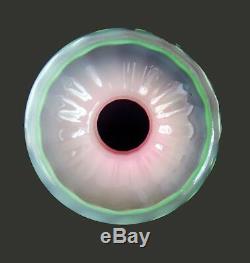
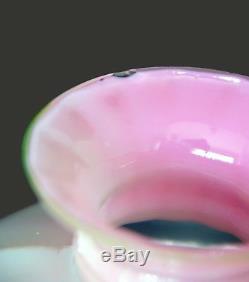
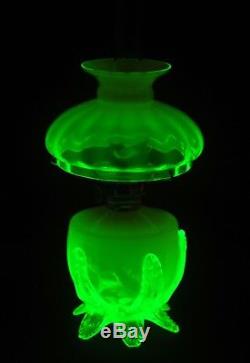

Pink & Green Optic 3782 S1-538. VERY RARE Antique Pink & Green Opalescent Optic Art Glass Miniature Oil Lamp with fancy applied feet, S1-538.
Cranberry Optic Art Glass Miniature Oil Lamp, S1-538. About 7 1/2 tall to top of shade. About 3 1/2 wide from foot to foot. Antique Opalescent Optic Molded Night Lamp.
Entire lamp flouresces brightly under "black" light. Very minor "nick" on top outer edge of shade; minor chips on 2 of the six applied feet and some grinding on the tips of 4 of the feet. Uranium oxide used to create the vivid green color causes lamp to fluoresce.
This beautiful art glass miniature oil or night lamp, is shown in Figure 538 of Frank & Ruth Smith's book "Miniature Lamps". According to Hulsebus (the "Price Guide for Miniature Lamps") this lamp has been found in cranberry glass with clear applied leaves and feet, in green and amber glass both with clear applied feet, in amberina glass with amber feet and in a pink and green opalescent glass (like this example). But is isn't found in any of these variations very often. We think that, in light of that data, this lamp is in fact "very rare" and as that implies very hard to find. Perhaps one reason why many of these lamps are rarely.
Found today is because not very many of them were made. These art glass lamps were not mass produced (as were many of the more commonly found Victorian era kerosene-fueled night lamps). Their manufacture was expensive and time consuming and required skilled glass artisans.
The glass on both the shade and the base of this lamp is faintly paneled. This faint paneling was achieved, according to Catherine Thuro ("Oil Lamps II"), by a technique known as "optic molding". In order to produce a lamp with a soft undulating pattern seen through a smooth exterior. Two molds were used; a patterned one and a larger plain one.
A gather of glass was first blown into the smaller patterned mold to produce a [piece] with relatively large and distinct protrusions. Still attached to the blowpipe the [piece] was removed from the patterned mold and placed inside the smooth larger mold. When the glass blower further expanded the [piece] against the smooth interior of the mold, it forced thick projections to the inside of the [piece] for the desired effect. The softness of the pattern distinguishes optic-molded [pieces] from the faceted or shaped designs made by pressing. (Thuro, Oil Lamps II, page 11).Second, the lamp is made primarily of a lovely and vibrant green glass. To obtain this color the glass chemists had to add uranium oxide to the glass mixture. After the base and shade were molded, a skilled glass artisan had to coat part of the glass with a thin layer of pink glass and then another very thin layer of opalescent glass had to be applied. To create the opalescent effect, this layer of glass had to be cooled and reheated. Finally a master glass maker had to apply the feet and the leaves which cradle the font by hand and inscribe both the feet and leaves with their striated pattern.
While we don't know what company made this lamp or when it was made, we suspect that it was made here in the U. And was probably made in the late 1800s or very early 1900s (the peak of Victorian night lamp production).
We believe that it was made in the U. Because of the use of U. One of Noe's lamps was similar to this lamp but had a differently shaped font.
That similarity (both lamps had identical optic molded shades) leads one to believe that this lamp could have be a Noe product, but we have no clear evidence that it was. Condition of this lamp: This lamp is in very good condition.
There is a small (about 1/32 wide) nick on the top outer edge of the shade (see photo #10). In addition there are very small chips on the tips of two of the six applied feet (which are not particularly apparent) and some minor polishing on the bottom of the tops of four of the feet which may have been done at the factory in order to ensure that the lamp stood straight.The old brass hardware on this lamp has been polished. The collar has no splits or cracks and is firmly attached to the font.
The Nutmeg burner (marked "MADE IN USA" on the thumb wheel) is also in fine condition; the thumb wheel turns freely (there is no wick in this lamp). An old style tripod (a wide brass ring with three bent brass arms) holds the shade firmly in place. The lamp comes with a clear glass chimney (with a polished top edge and a rough-cut bottom edge, also in fine condition), which completes this lamp. This is truly an outstanding example of an extremely hard to find Victorian night lamp, or miniature oil lamp. It is in remarkably good condition.
About the Use of Words Like "Scarce" and "Rare". We realize that some eBayers, not having or knowing of a better way of assessing an item's scarcity, use these terms quite subjectively and frequently based on their own personal experience.They simply don't know whether an item is common, scarce or rare. We take two steps to describe the scarcity of a lamp. First, we only use the words "Scarce", "Rare", "Very Rare", "Very Very Rare" and "Extremely Rare" if the item in question is judged to be so by an acknowledged outside and independent source.
For miniature lamps, we use the ratings in Marjorie Hulsebus 2006 edition of the "Price Guide for Miniature Lamps". Marjorie's ratings are also somewhat subjective (they are based on the collective view of a panel of 12 experienced miniature lamps collectors--we were members of that panel). But were at least arrived at independently of the sale or offering of any particular lamp. We keep all of this data in an online database and make the database available free of charge to members of the Night Light Club and to others who have requested access.Fluorescence in Old Clear Glass. , found naturally as the mineral Pyrolusite, was used by by glass makers, as far back as ancient Egyptian and Roman times and up until about 1915, as a decolorizing agent in order to make clear, colorless glass. The natural material used to make glass contains iron impurities. These impurities impart a coke-bottle green (and sometimes brown) color to the glass. Manganese dioxide, added to the molten glass mixture, neutralizes the coloring effects of the iron impurities.
Adding manganese to glass has a side-effect of which we doubt old glass makers were aware. While not itself fluorescent, manganese activates fluorescence in other elements or compounds. Clear glass which has had manganese dioxide added to it will glow with a green or yellow-green color when viewed under long wave ultra-violet ("black") light. This fluorescence turns out to be a useful test of the age of clear glass.The United States does not have large amounts of naturally occurring Pyrolusite; the mineral has to be imported from places like the Ukraine, South Africa, Brazil, Australia and China. After the outbreak of World War I in Europe, manganese became increasingly hard to get; first, it was considered a strategic war material (it is essential to iron and steel production) and, second, the normal supplies lines were disrupted by the war. And, so, after about 1915, U. Glass makers switched to other decolorizing agents e.
Thus, clear glass which fluoresces (glows) under ultra-violet ("black") light can be presumed to have been made before 1915. Incidentally, manganese dioxide is also the compound responsible for the "sun-purpling" of old clear glass; when exposed to short-wave ultra-violet light (present in sun-light, or in germicidal lamps) over an extended period of time, the manganese dioxide will impart a purplish color to the glass. It has been reported that unscrupulous antique dealers especially in the Southwestern U. Would intentionally expose old glass to the intense desert sun (or to ultra-violet germicidal lamps) to create this purple color. Purists among glass collectors consider this to be a travesty and believe that intentional or artificial sun-purpling decreases, rather than enhances, the value of old glass items.Note that is can be quite challenging to get an accurate i. That looks the same as what one sees with their eyes photograph of the fluorescence in the glass. We work hard to get a photograph that looks like what we see, but there is usually some minor discrepancy either in the exact color or amount of the fluorescence. Should you examine a fluorescent lamp under black light, in a darkened environment, it will glow, but may not look exactly like the photograph we provided. The manufacture of dark red, or "ruby", glass was a delicate and expensive process.
It required adding a solution of gold dissolved in Aqua Regia (a mixture of hydrochloric and nitric acids) to the molten glass mixture. Getting the proportions of gold and acid correct was critical; minor errors resulted in an unattractive muddy color rather than the desired clear bright red color. The amount of the gold and acid solution added to the molten glass determined the darkness of the color. Somewhat less solution resulted in a lighter colored "cranberry" glass while more of the solution resulted in a deep red "ruby" colored glass. A further complication is that initially the resulting glass looks gray and only turns to the desired red color when the glass is reheated. Because of the complexity of the process, "ruby" or "cranberry" glass was generally only made in small or "craft" quantities. This process is believed to have been initially discovered by early Roman glass-makers.The process however was lost and was not rediscovered until sometime in the 17th Century either by Johann Knuckel in Bohemia or by Antonio Neri in Florence, Italy (experts are uncertain as to who deserves the credit). It was not however until the 1920s that the chemistry was understood and explained (by 1925 Nobel Laureate in Chemistry Richard Zsigmondy). The legend that ruby, or cranberry, glass was first created when a nobleman tossed a gold coin into a vat of molten glass is just that. A legend without a basis in fact since the gold would have had to been first dissolved in Aqua Regia. The height of ruby and cranberry glass production appears to have been during the Victorian era.
The contents of this listing are protected by U. The use of substantial portions of this listing verbatim or with only inconsequential changes without the express written consent of the authors is prohibited. Our objective is to have happy, satisfied customers. We will work with you to satisfactorily resolve any problems. We try to answer all questions promptly.We do our best to describe all items accurately. However, mistakes and oversights can occur.
Please also note that the receiving country's Custom Service may cause delays in item's arrival. Interested in learning more about miniature lamps? Want to meet other miniature lamp collectors? Please check out our other listings.
The item "VERY RARE Antique Pink & Green Opalescent Art Glass Miniature Oil Lamp, S1-538" is in sale since Wednesday, February 6, 2019. This item is in the category "Collectibles\Lamps, Lighting\Lamps\ Non-Electric\Miniature". The seller is "kayschwartz" and is located in Stockton, New Jersey. This item can be shipped worldwide.
- Featured Refinements: Antique Miniature Oil Lamp

